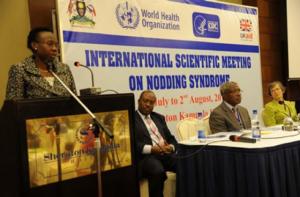Nodding Syndrome meeting, researchers agree on case definition and establish research agenda
Kampala, 1 August 2012 -- The First International Scientific Meeting on Nodding Syndrome (NS) concluded its third day of proceedings by finalizing a standard case definition and identifying critical next steps in a research agenda that will guide future scientific studies.
Over the last two days, the meeting participants heard presentations from representatives who have conducted studies in Uganda, South Sudan and Tanzania. These presentations provided insight into the different research activities that have taken place in each country and progress made to date.
The key objective achieved by the meeting was a standardized case definition for suspect and probable cases of NS. Although the multinational audience has referred to this illness as ‘Nodding Disease’ and ‘Head Nodding Disease’ in the past, a consensus was reached to refer to the combination of signs and symptoms as Nodding Syndrome.
This term will provide consistency across all research activities in the future. The researchers and representatives from thethree countries identified key strategic steps that the meeting participants should take to move forward on NS research. For example, researchers should conduct systematic surveys to determine prevalence, burden, and geographic distribution of NS. Other topics for next steps include clinical case management, collaborative research with conference participants, and the involvement of additional specialty fields in research including anthropology.
In their closing remarks, leaders from the Uganda Ministry of Health, World Health Organization (WHO), Centers for Disease Control and Prevention (CDC) and the UK Department of International Development (DFID) all expressed their thanks and gratitude to the researchers, conference participants and the media. As the chairman of the closing ceremony, Dr. Anthony Mbonye, Ministry of Health, expressed, “When we came here on Monday, we aimed to have a case definition. We aimed to have a research agenda. We aimed to have research collaboration. I think we achieved these things”.
Dr. Jenny Amery, DFID, further expressed her perception of one of the meetings outcomes, “we worked on taking forward the important issues of care and management of the poor children affected by this syndrome.” In his closing remarks, Dr. Scott Dowell, CDC, reminded the participants of the significance of these deliberations, but redirected the attention to the children with NS. Dr. Dowell said, “I hope that we hold on to a sense of urgency that the kids with this syndrome deserve.”
The WHO Country Representative Dr Joaquim Saweka noted that “the syndrome is still with us and we need to use the information shared in this meeting to alleviate the suffering of the affected childrens much as possible”. Uganda’s Director General of Health Services Dr Jane Ruth Aceng closed the meeting on behalf of the Health Minister with a series of remarks that complimented the participants on the success of the meeting and urged the participants and Ministries of Health to continue to move the scientific research forward. Dr. Aceng insisted that coordinated collaboration in NS research is necessary; she said “If we work in an uncoordinated way, we will not make progress with Nodding Syndrome.”
The Dr. Aceng concluded the meeting by making an appeal to address some of the challenges ahead. “If we retreat to our countries and business as usual, we will not make progress. We need to keep in touch and update each other of progress. Nodding syndrome is here with us and will remain with us, but it will get better. It was much better today than it was yesterday.”
__________________________________________________________
For more information please contact:
Benjamin Sensasi, Health Promotion Advisor,
WHO Country Office
Tel 256-41-334400
Email: sensasib [at] ug.afro.who.int (sensasib[at]ug[dot]afro[dot]who[dot]int)



